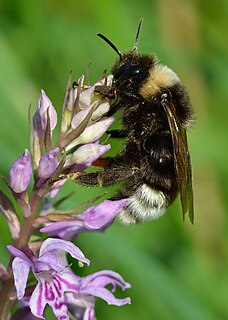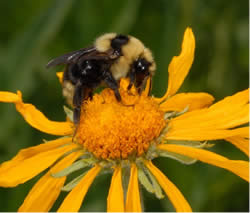
A bumblebee is any of over 250 species in the genus Bombus, part of Apidae, one of the bee families. This genus is the only extant group in the tribe Bombini, though a few extinct related genera are known from fossils. They are found primarily in higher altitudes or latitudes in the Northern Hemisphere, although they are also found in South America, where a few lowland tropical species have been identified. European bumblebees have also been introduced to New Zealand and Tasmania. Female bumblebees can sting repeatedly, but generally ignore humans and other animals.

Bombus terrestris, the buff-tailed bumblebee or large earth bumblebee, is one of the most numerous bumblebee species in Europe. It is one of the main species used in greenhouse pollination, and so can be found in many countries and areas where it is not native, such as Tasmania. Moreover, it is a eusocial insect with an overlap of generations, a division of labor, and cooperative brood care. The queen is monandrous which means she mates with only one male. B. terrestris workers learn flower colors and forage efficiently.

Cuckoo bumblebees are members of the subgenus Psithyrus in the bumblebee genus Bombus. Until recently, the 28 species of Psithyrus were considered to constitute a separate genus. They are a specialized socially parasitic lineage which parasitises the nests of 'true' bumblebees, resulting in the loss of the ability to collect pollen and establish their own nests. Cuckoo bumblebees do not create a worker caste and produce only male and female reproductives. They are considered inquilines in the colonies of 'true' bumblebees.

The early bumblebee or early-nesting bumblebee is a small bumblebee with a wide distribution in most of Europe and parts of Asia. It is very commonly found in the UK and emerges to begin its colony cycle as soon as February which is earlier than most other species, hence its common name. There is even some evidence that the early bumblebee may be able to go through two colony cycles in a year. Like other bumblebees, Bombus pratorum lives in colonies with queen and worker castes. Bombus pratorum queens use aggressive behavior rather than pheromones to maintain dominance over the workers!

The tree bumblebee or new garden bumblebee is a species of bumblebee common in the European continent and parts of Asia. Since the start of the twenty-first century, it has spread to the United Kingdom and Iceland. These bumblebees prefer habitats that others do not, allowing them to pollinate flowers in areas that many other species do not get to.

Bombus vestalis, the vestal cuckoo bumblebee, is a species of cuckoo bumblebee that lives in most of Europe, as well as North Africa and western Asia. It is a brood parasite that takes over the nests of other bee species. Its primary host is Bombus terrestris. After its initial classification as Psithyrus vestalis, this bumblebee recently was reclassified into the genus Bombus, subgenus Psithyrus.

Bombus insularis is a species of bumblebee in the subgenus Psithyrus, the cuckoo bumblebees. It is native to northern and western North America, where it occurs throughout Canada, Alaska, the northern United States, and some western states. It is known commonly as the indiscriminate cuckoo bumblebee.

Bombus balteatus, the golden-belted bumble bee, is a species of bumblebee with a boreal and high altitude distribution in northern Eurasia and North America.

Bombus monticola, the bilberry bumblebee, blaeberry bumblebee or mountain bumblebee, is a species of bumblebee found in Europe.

The heath humble-bee or small heath bumblebee, Bombus jonellus, is a species of bumblebee, widely distributed in Europe and northern Asia, as well as northern North America.

Bombus hortorum, the garden bumblebee or small garden bumblebee, is a species of bumblebee found in most of Europe north to 70°N, as well as parts of Asia and New Zealand. It is distinguished from most other bumblebees by its long tongue used for feeding on pollen in deep-flowered plants. Accordingly, this bumblebee mainly visits flowers with deep corollae, such as deadnettles, ground ivy, vetches, clovers, comfrey, foxglove, and thistles. They have a good visual memory, which aids them in navigating the territory close to their habitat and seeking out food sources.

Bombus pascuorum, the common carder bee, is a species of bumblebee present in most of Europe in a wide variety of habitats such as meadows, pastures, waste ground, ditches and embankments, roads, and field margins, as well as gardens and parks in urban areas and forests and forest edges. It is similar in appearance to Bombus muscorum, and is replacing the species in Northern Britain.

Bombus lucorum, the white-tailed bumblebee, is a species of bumblebee, widespread and common throughout Europe. This name has been widely used for a range of nearly identical-looking or cryptic species of bumblebees. In 1983, Scholl and Obrecht even coined the term Bombus lucorum complex to explain the three taxa that cannot be easily differentiated from one another by their appearances. A recent review of all of these species worldwide has helped to clarify its distribution in Europe and northern Asia, almost to the Pacific. B. lucorum reaches the Barents Sea in the North. However, in southern Europe, although found in Greece it is an upland species with its distribution never quite reaching the Mediterranean.

Bombus fervidus, the golden northern bumble bee or yellow bumblebee, is a species of bumblebee native to North America. It has a yellow-colored abdomen and thorax. Its range includes the North American continent, excluding much of the southern United States, Alaska, and the northern parts of Canada. It is common in cities and farmland, with populations concentrated in the Northeastern part of the United States. It is similar in color and range to its sibling species, Bombus californicus, though sometimes also confused with the American bumblebee or black and gold bumblebee. It has complex behavioral traits, which includes a coordinated nest defense to ward off predators. B. fervidus is an important pollinator, so recent population decline is a particular concern.

Bombus ruderatus, the large garden bumblebee or ruderal bumblebee, is a species of long-tongued bumblebee found in Europe and in some parts of northern Africa. This species is the largest bumblebee in Britain and it uses its long face and tongue to pollinate hard-to-reach tubed flowers. Bumblebees are key pollinators in many agricultural ecosystems, which has led to B. ruderatus and other bumblebees being commercially bred and introduced into non-native countries, specifically New Zealand and Chile. Since its introduction in Chile, B. ruderatus has spread into Argentina as well. Population numbers have been declining and it has been placed on the Biodiversity Action Plan to help counteract these declines.

Bombus ruderarius, commonly known as the red-shanked carder bee or red-shanked bumblebee, is a species of bumblebee found in Eurasia.

Bombus terricola, the yellow-banded bumblebee, is a species of bee in the genus Bombus. It is native to southern Canada and the east and midwest of the United States. It possesses complex behavioral traits, such as the ability to adapt to a queenless nest, choose which flower to visit, and regulate its temperature to fly during cold weather. It was at one time a common species, but has declined in numbers since the late 1990s, likely due to urban development and parasite infection. It is a good pollinator of wild flowers and crops such as alfalfa, potatoes, raspberries, and cranberries.

The half-black bumblebee is a small bumblebee with a wide distribution in North America, its range extending from Ontario to Nova Scotia and southward to Georgia.


















